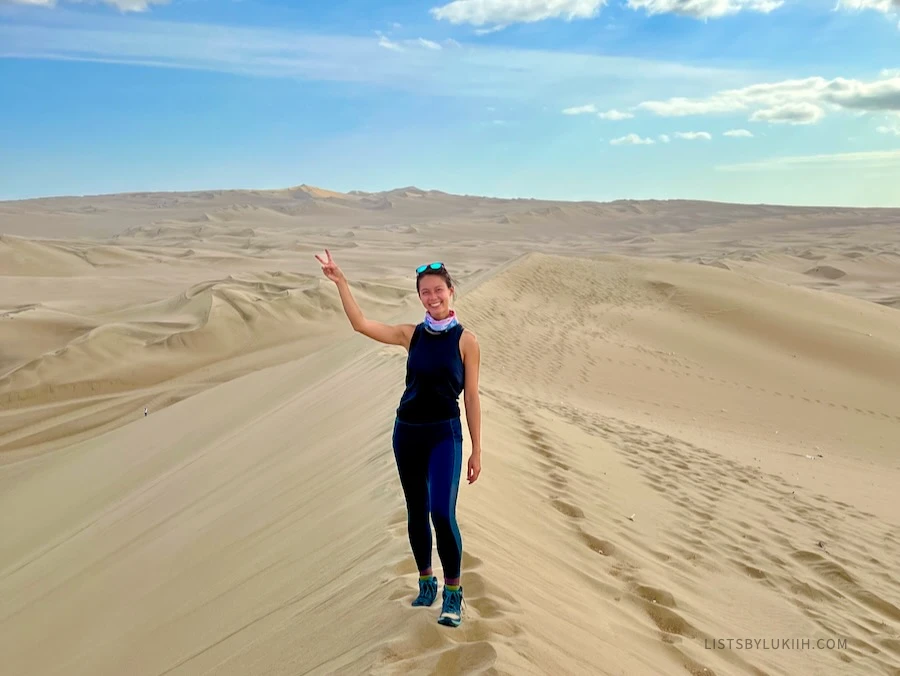Receiving over 2 million tourists last year in 2023, Peru is a popular destination in South America that is known for its Inca ruins, desert oasis, and breathtaking natural wonders.
Having experienced an incredible trip in Peru, I share must-know travel tips that are especially useful for first-time visitors.
This Peru guide is also informed by Isabela, my childhood friend who’s lived in Peru for the past 10+ years.
- 1. Best Places To Visit
- 2. When To Visit
- 3. How Long To Spend
- 4. Entry Requirements
- 5. Budgeting & Cash
- 6. How To Get Around
- 7. How To Stay Safe
- 8. Language Barrier
- 9. Cultural Differences
- 10. Food To Try
- 11. Itinerary Tips
Lists By Lukiih is readers-supported. When you buy with my affiliate link, I may earn a small commission. Thanks!
1. Best Places To Visit in Peru
Peru has incredible places to visit ranging from breathtaking mountains to floating villages in lakes to major cities.
Below are Peru’s most popular destinations and the top things to see and do in each location.
📍 Machu Picchu
Located in the Andes Mountains, Machu Picchu is one of the Seven Worlds of the World.
The Inca ruin is Peru’s most famous archaeological site and features the ancient civilization’s remarkable architecture. The ruin’s backdrop of Huayna Picchu mountain is also an iconic symbol of Peru.
Visitors can take a bus or trek the multi-day Inca Trail to Machu Picchu. Either way, everyone needs to pass through the town of Aguas Calientes, which acts as a gateway to the Inca ruins.
See how to hike the Inca Trail to Machu Picchu.
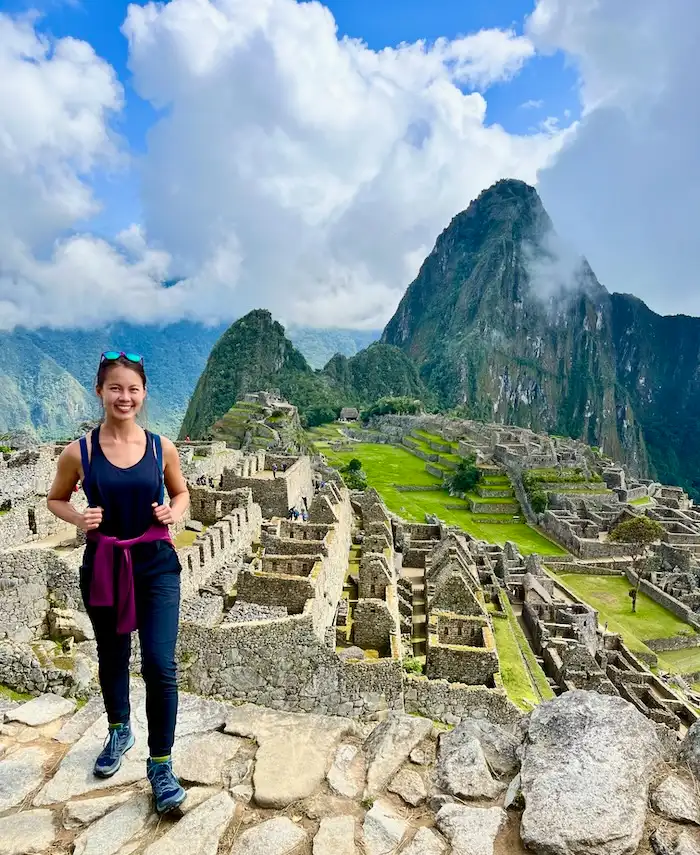
📍 Cusco, Rainbow Mountain and Sacred Valley
Cusco was the capital of the Inca Empire and is a UNESCO World Heritage Site with historical and cultural significance. Top attractions in Cusco include:
- Plaza de Armas, the historical main square lined with colonial buildings
- San Pedro Market, a bustling local market that sells local crafts
- Chinchero, a nearby town for its markets and Inca archaeological sites
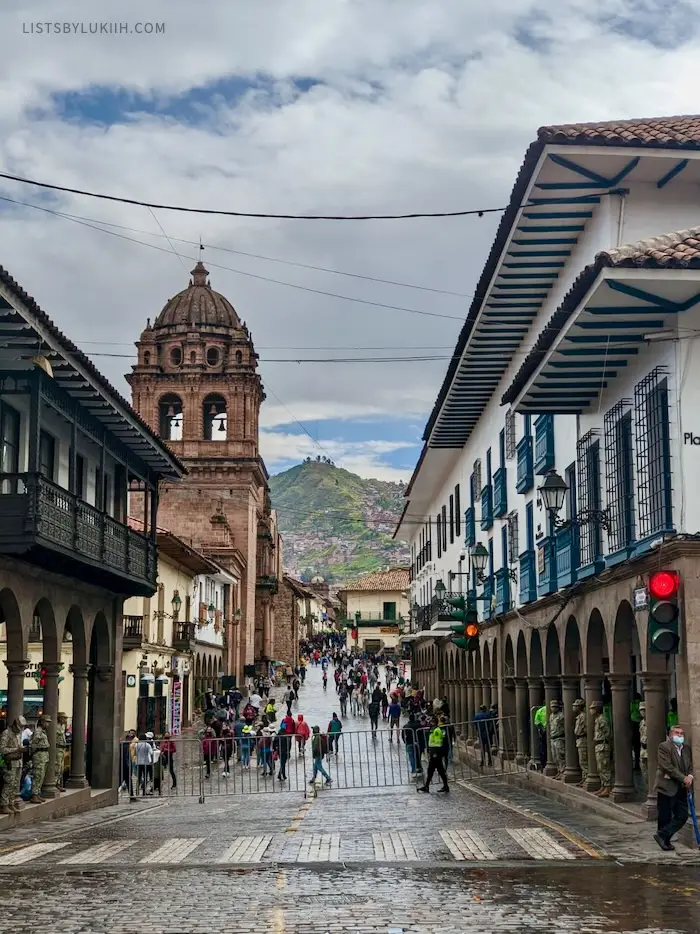
Cusco is also the gateway to many of Peru’s top attractions, including Machu Picchu.
Inca Trail hikers typically stay in Cusco for at least a day to acclimate to the high altitude and combat altitude sickness. The city is located over 11,000 feet above sea level.
The city is also located near two other popular attractions:
- Rainbow Mountain is a geological marvel with vibrant colors due to the minerals. It’s also called Vinicunca and “Montaña de Siete Colores” (Mountain of Seven Colors).
- Sacred Valley of the Incas, also called Urubamba Valley, is a historically significant region.
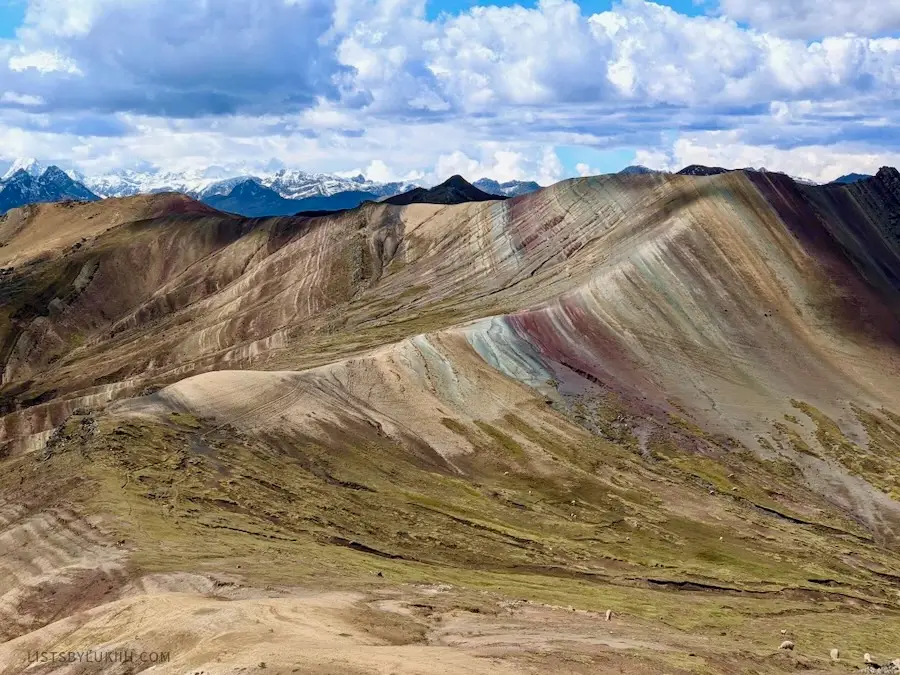
📍 Lima
The capital city of Lima is Peru’s largest and most metropolitan city and features several cultural and culinary attractions. Top places to check out in Lima include:
- Historic Centre of Lima, a UNESCO World Heritage Site with well-preserved colonial architecture
- Miraflores, a vibrant district featuring parks, art galleries, and ocean views
- Larco Museum, a culturally significant museum
Lima is considered the gastronomic capital of South America. The city has both street food and high-end restaurants. One way to sample Peruvian food is by going on a highly-rated Lima food tour.
📍 Lake Titicaca
Lake Titicaca is South America’s largest lake and is known for the surrounding stunning nature.
It’s also a significant place for several indigenous communities. One such group, the Uros people, inhabits floating islands called the Uros Islands.
Tourists visiting Lake Titicaca can experience a range of activities including hiking around the beautiful scenery, getting a cultural tour of the Uros Islands, going on boat rides, and attending festivals.
📍 Arequipa and Colca Canyon
Colca Canyon is another of Peru’s natural wonders that’s known for its beautiful scenery and deep canyons. It’s a popular place for hiking and bird-watching.
The gateway to Colca Canyon is Arequipa, Peru’s second-largest city. It’s nicknamed the “White City” because many of its buildings use white volcanic rock.
📍 Huacachina
Huacachina is a small town and is known as the only desert oasis in South America. Due to its high sand dunes, it’s a world-renowned spot for sandboarding and dune buggy riding.
Huacachina is a popular day trip destination from Lima. A typical Huacachina guided tour will also stop to see the mysterious Nazca Lines and the interesting Ballestas Islands.
Learn Huacachian sandboarding tips.

📍 Puerto Maldonado and the Amazon Rainforest
Puerto Maldonado is a southeastern city that’s known as the gateway to the Amazon rainforest, one of the most biodiverse regions in the world that’s famous for its wildlife (e.g., macaws, jaguars, exotic birds).
Visitors usually travel to Puerto Maldonado to start their jungle tours, aerial walkways, and canopy tours. It’s a great place for nature enthusiasts.
🍀 My Take on Machu Picchu, Cusco, Lima and Huacachina
I visited four of the best places in Peru during my trip and I was amazed by the nature.
- Hiking the Inca Trail to Machu Picchu was one of my trip’s highlights. The scenery was beautiful and the experience made me appreciate the Inca’s engineering.
- Cusco was a charming area to explore. I wish I had also prioritized visiting nearby Rainbow Mountain or Sacred Valley.
- I don’t recommend spending significant time in Lima as it’s just a big city. I didn’t find it particularly unique even if it does have some nice districts to walk around.
- Huacachina was one of my other favorite places. The towering sand dunes were breathtaking and sandboarding there was thrillingly fun.
This 10-day Peru itinerary features my trip’s highlights.
2. When To Visit Peru
Peru has very different climates by region due to its diverse landscape which includes the desert, high mountains, and the Amazon rainforest.
☀️ Best Time To Visit Peru
The best time to visit Peru is during the dry season, which generally runs from April to November.
This is also the high season, so it’s a good idea to book your trip early if you visit then.
Peru’s rainy season runs from November to April with January to April being the wettest months. During the rainy season, you’ll see fewer crowds and very lush scenery.
🍃 Peru’s Seasons
Due to Peru’s diverse landscape, the country experiences different seasons based on the region. In general, Peru can be split into three regions for climate purposes:
| Region | Areas in the Region | Seasons |
|---|---|---|
| Coast | – Lima – Huacachina | – Summer (Dec-Mar) averages 75-92 °F – Winter (Jun-Sep) averages 58-73 °F |
| Highlands | – Cusco – Arequipa – Colca Canyon – Lake Titicaca | – Dry season (May-Oct) has clear skies & sunny days – Wet season (Nov-Apr) has heavier rainfall |
| Amazon Rainforest | – Manaus | – Dry season (Jun-Sep) has lower rainfalls – Wet season (Dec-Mar) has heavier rainfall |
If you’re hoping to hike to Machu Picchu, note that the Inca Trail is closed every February to allow the trail to recover.
🍀 My Experience With Peru’s Weather
I visited Peru in April because I wanted to do the Inca Trail hike, which is best during the dry season and it’s less crowded towards the beginning of the season.
I experienced warm weather and was wearing summer clothes except for the times I was at high altitudes.
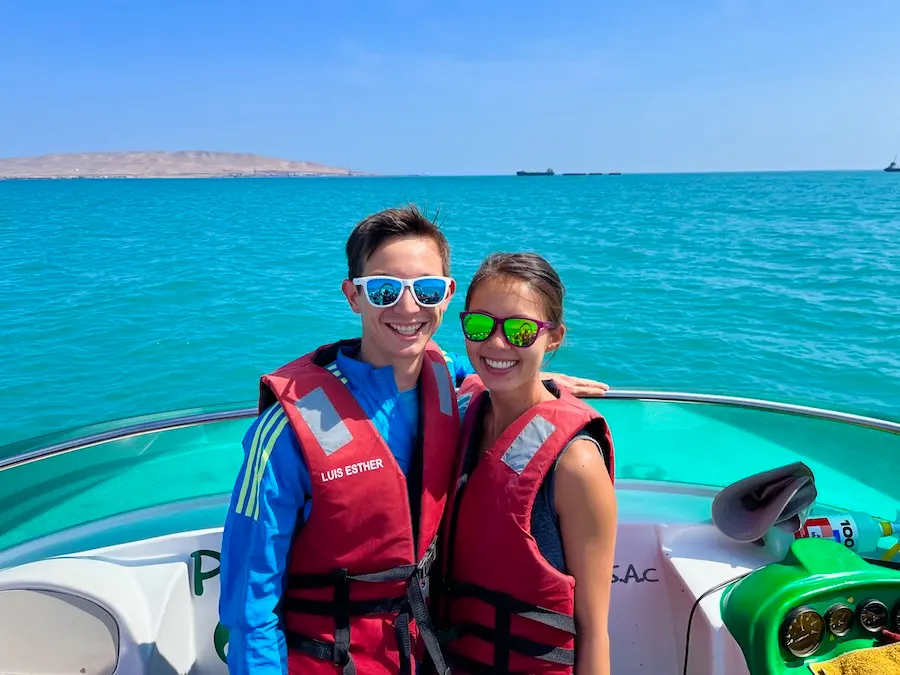
3. How Long To Spend in Peru
Peru is a large country (in fact, it’s the 20th largest in the world) where visitors typically spend 10 to 14 days traveling.
🗓️ How Many Days Do You Need in Peru?
First-time visitors should spend at least a week in Peru to appreciate cultural treasures like Machu Picchu, see a city, and explore other natural wonders.
- With three to five days in Peru, you’ll have enough time to visit the capital city of Lima and visit a further away area, but you won’t have much time for any excursions or hikes.
- With seven to ten days in Peru, you’ll have enough time to visit Cusco, Machu Picchu, and nearby attractions like Sacred Valley or Rainbow Mountain.
See how to spend ten days in Peru.
- With more than two weeks in Peru, you’ll have the chance to visit more remote areas like Lake Titicaca while also visiting some of the typical top attractions.
🍀 How Long I Stayed in Peru
I stayed in Peru for ten days, which gave me enough time to visit Lima, Cusco, Machu Picchu, and Huacachina.
By the end of my trip, I felt that I could have spent an extra three days or so to do some nearby attractions like Rainbow Mountain, which I’m sad to have missed.
4. Entry Requirements for Peru
The entry requirement for Peru is straightforward for US citizens.
🛃 Peru’s Visa and Passport Requirements
A tourist visa is not required for United States citizens visiting Peru. A visa is issued for free at the point of entry.
Also, your US passport must be valid for six months beyond the first day of your Peru trip.
🍀 My Experience Entering Peru
Being an American citizen comes with the privilege of holding one of the world’s most powerful passports, so I had no issues flying into Lima, Peru.
5. Budgeting and Cash in Peru
Peru is an affordable tourist destination for South America.
💰 Expected Budget in Peru
Here’s approximately how much you can expect to spend when visiting Peru:
| Travel Style | Budget per Day |
|---|---|
| Budget Travelers | $35 |
| Mid-Range Budget Travelers | $120 |
Peru has a low cost of living, but travel expenses can quickly add up when you do popular tours and excursions to the many natural wonders.
🏧 Do You Need Cash In Peru?
Peru’s economy is still largely based on cash transactions, so make sure to bring cash.
Peru also has a tipping culture, so I always had cash on hand to tip tour guides, restaurant workers, and other service workers.
💵 Are US Dollars Accepted in Peru?
Peru’s local currency is the Peruvian sol (S/). The US dollar is widely accepted, but you may not get the best conversion rate, so it’s best to use soles.
The exchange rate was $1 USD = 3.76 Sol at the time of writing.
🍀 My Peru’s Trip’s Budget
I share all my travel expenses and credit card usage in this Peru budget breakdown.
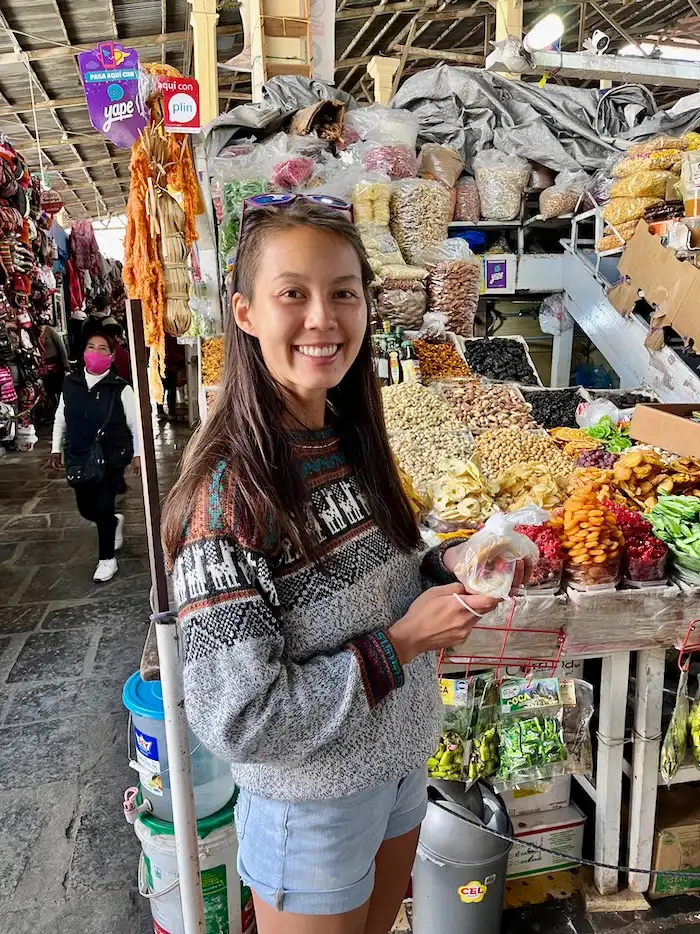
6. How To Get Around in Peru
There are several ways to get around Peru and renting a car is not the most efficient way.
✈️ Flying Into Peru
Peru has several international airports to fly into and the main ones are:
| Airport | Location |
|---|---|
| Jorge Chávez International Airport (LIM) | Lima |
| Alejandro Velasco Astete International Airport (CUZ) | Cusco |
| Rodríguez Ballón International Airport (AQP) | Arequipa |
When you arrive at a Peru airport, ignore the aggressive taxi drivers following you and telling you that Uber or Lyft is illegal (it’s not true). Walk with confidence towards your pre-arranged or ridesharing vehicle.
Once you land in Peru, there are several common ways to get around the country.
🚙 Renting a Car and Driving in Peru
Renting a car is generally not advised in Peru for a variety of reasons:
- Driving is not necessarily cost-effective due to the long distances you have to travel to get from one area to another. For example, driving between Lima and Cusco takes over 20 hours.
- In cities like Lima, traffic is bad and Peruvian drivers are known to be aggressive.
- Outside of the cities, Peru’s road conditions can be poor with unclear road signs, unpaved roads, and a lot of potholes.
- Cell and GPS signals can be weak or nonexistent in certain areas, even on roads between two popular areas.
Unless you understand and accept the risks and inconveniences outlined above, you should instead consider taking buses, flights, taxis, and rideshares in Peru.
🗺️ Getting Around Different Regions in Peru
Navigating around Peru’s different regions can be challenging as the country is large and doesn’t have reliable public transportation.
The two safest and best ways to travel to different regions of Peru are by riding a bus or flying.
🚌 Option 1: Riding the Bus in Peru
The most budget-friendly way to get around Peru is by booking a private bus through a bus company.
Riding private buses is not the same as riding local buses, which can be challenging to navigate as a tourist.
Several bus companies offer stops around Peru, with Peru Hop being one of the most well-known ones. I used them to book my tour to Huacachina.
Make sure to research your Peru bus company before using them as the reliability and quality varies by company and location.
✈️ Option 2: Taking Domestic Flights in Peru
Peru has over 200 airports, so taking domestic flights to travel long distances is an option.
Flying is generally much more expensive than taking a bus in Peru, but it’s sometimes the best way to get around due to reasons related to safety or convenience.
🚕 Getting Around a Town or City in Peru
Once you’re in a city or town in Peru, you can rely on taxis and ridesharing apps, like Uber and Lyft to get around. Ridesharing apps are only available in tourist, non-remote areas like Lima and Cusco.
Uber and Lyft are ridiculously cheap in Peru, so consider taking them over taxis.
🍀 How I Got Around Peru
I didn’t rent a car in Peru for the reasons stated above and instead relied on Uber, bus companies, and domestic flights to get around.
- Between Lima and Cusco, I took a flight as driving between these two areas was daunting and long.
During my Peru trip, all flights to Cusco were canceled for a day due to an air traffic control protest. Protests are unfortunately common in Peru.
- From Lima to Huacachina, I took a bus as part of my Huacachina tour. The bus was well-maintained and comfortable (it even had curtains to block out the sun). You should not expect this level of comfort on local buses.
- While in Lima and Cusco, I relied on taxis and Ubers to get around. They were pretty straightforward.
7. How To Stay Safe in Peru
Here are safety tips to keep in mind when traveling to Peru.
⚠️ Is Peru Safe to Visit?
Like many countries in South America, Peru is safe to visit in tourist areas, but it’s important to exercise some precautions and avoid places with high crimes.
See the OSAC Peru Country Security Report to see areas with high crime rates.
Petty theft like pickpocketing and bag-snatching is a common thing to look out for in Peru. Kidnapping and more violent crimes do happen, but they’re rare.
Peru has a travel advisory level of 2 per the US Department of State and is ranked #103 out of 163 safest countries by the Global Peace Index (for reference, the United States is ranked #131).
🦙 Common Scams in Peru
Here are common scams to watch out for in Peru:
- Taking photos with or petting baby alpacas is a common tourist activity in Peru. The standard price for this is about 10 soles (about $2), but some alpaca owners will pressure tourists to pay much more, so make sure to agree on a price in advance.
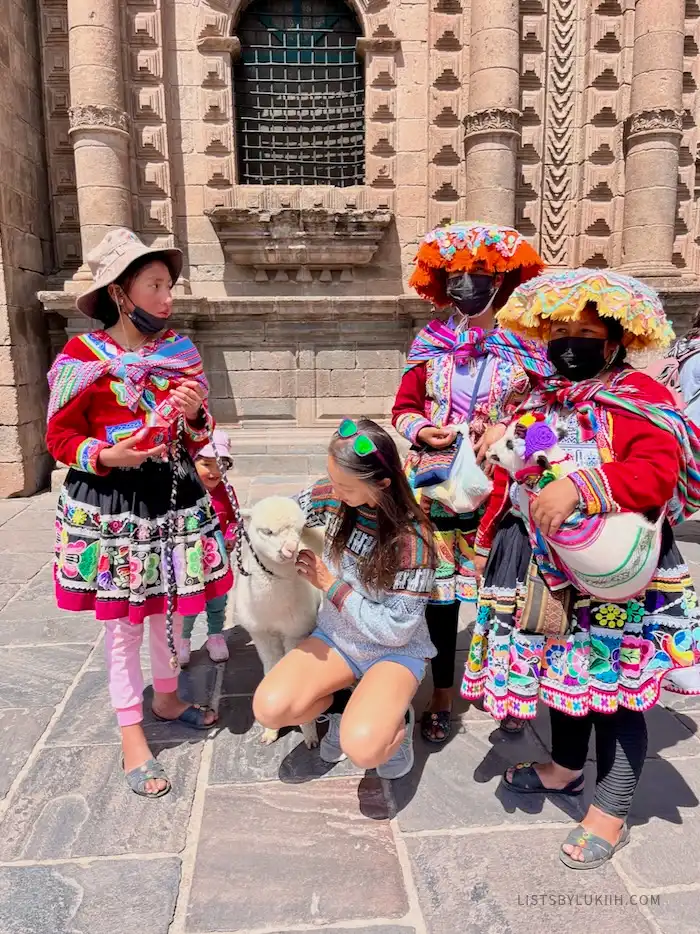
- Tourists get shortchanged money a lot, so always check your change.
- Counterfeit money is also a common problem, so don’t exchange large bills with strangers and only withdraw cash from an ATM.
- The taxi scam is a fairly common tourist scam and it happens in Peru as well. Taxi drivers refuse to turn on their meters or claim that their meter is broken. You should only get into taxis with functioning meters.
💧 Is Tap Water Safe To Drink in Peru?
Tap water is not safe to drink in Peru, but you can drink boiled or filtered water there. Many tour companies will provide bottled water to visitors.
If you have a sensitive stomach, avoid eating raw vegetables and street foods in Peru. It’s not rare to get an upset stomach or food poisoning.
🦟 Does Peru Have Mosquitoes?
Peru has mosquitos and some areas have high risks of diseases like dengue, Zika, malaria, and yellow fever, so protect yourself as best as you can.
Mosquitos are especially prevalent in the Amazon Rainforest and rural areas of Peru.
🍀 My Safety Tips for Peru
Based on my local friend’s advice and having spent time in tourist areas of Peru, I recommend these safety tips:
- Do not display valuables. While Peru is considered a middle-income country, it has many issues of a low-income country, so it’s common for criminals to target tourists who display wealth (e.g., jewelry, expensive clothes and bags, large amounts of cash).
- Always keep your bag close. Motorcycles riding by and stealing visitors’ bags from a taxi or vehicle are not uncommon, especially in certain places with bad traffic like Lima.
- Check for civil unrest. Unfortunately, protests are common in Peru and can significantly impact travel plans when roads or services close down. Many protests are planned in advance and around the holidays, so you can get a heads-up.
When I did the Inca Trail trek to Machu Picchu, my hike was impacted by protests twice.
- Cross the streets carefully. Unlike the United States, pedestrians do not have the right of way and there are no cultural norms to stop for them in Peru.
I learned from personal experience that stop signs are suggestions and many cars will not stop.
- It’s a good idea to pack some insect repellent. I’m a mosquito-magnet and I didn’t see many mosquitos in cities like Lima and Cusco, but I saw them during the beginning of my Inca Trail hike.
Overall, I found that Peruvians are generally kind people who will try to help you if you need it. But keep in mind that Peru is also one of the poorest countries in South America, so they will upcharge or rob tourists in poorer areas if the opportunity presents itself.
8. Language Barrier in Peru
Peru’s official language is Spanish.
🗣️ Is English Common in Peru?
Peru is only English-friendly in tourist areas, but English is otherwise not widely spoken. Roughly 8% of Peru’s population speaks some English and that percentage drops in smaller towns.
Here are some common Spanish words and phrases to know while visiting Peru:
| Common Word or Phrase | English Translation |
|---|---|
| Hola | Hello |
| Gracias | Thank you |
| ¿Habla Inglés? | Do you speak English? |
| ¿Cuánto cuesta? | How much does it cost? |
🍀 Traveling Peru With Just English
I found getting around Peru fairly easy as I stayed in tourist areas like Lima and Cusco and was always with a tour guide for bigger excursions.
I imagine that navigating without any Spanish gets harder in rural areas and without a guide.
9. Cultural Differences in Peru
Peruvian culture has been influenced by its indigenous heritage, Spanish colonial history, and various immigrant groups.
🤗 Cultural Norms in Peru
Here are a few cultural norms and etiquette to keep in mind when visiting Peru:
- Spanish is the official language, but many Peruvians in rural places speak indigenous languages such as Quechua. Some might even show a nuanced dislike for Spanish.
- Peru’s local communities can be as diverse as the landscape of the country. Many traditions, including the way people dress, can vary across regions, so don’t treat Peruvians as a homogenous group.
- Compared to Americans, people from Peru are more comfortable with closer personal space and physical contact (e.g., cheek kisses are not uncommon among acquaintances).
- While guided tours will run on time in Peru, Peruvians generally have a more relaxed view of time. Punctuality is not as highly valued.
🍀 My Experience With Peru’s Culture
Like many other visitors, I didn’t experience any culture shock in Peru.
Peruvians are generally friendly and warm towards foreigners, but you might be surprised by some of the Peruvian cuisine (e.g., guinea pig is a delicacy).
10. Peruvian Food To Try
Peruvian cuisine is known to be well-seasoned and diverse. Lima is considered the culinary capital of South America thanks to fresh ingredients, deep-rooted traditions, top culinary talent, and international influence.
While visiting Peru, don’t forget to try some of their best-known dishes and drinks:
- Lomo saltado is a traditional Peruvian dish that has strips of sirloin with onion and tomatoes and is typically served with rice.
- Pisco sour is the national drink of Peru. It’s an alcoholic cocktail with pisco liquor, lime juice, simple syrup, and egg whites.
- Ceviche, which is raw seafood combined with lime, onions, and other ingredients, is popular.
To avoid the chance of an upset stomach, eat ceviche in coastal areas like Lima. My local friend does not recommend getting it in places like Cusco.
- Anticuchos are skewers of grilled and well-marinated meat, usually made with beef hearts.
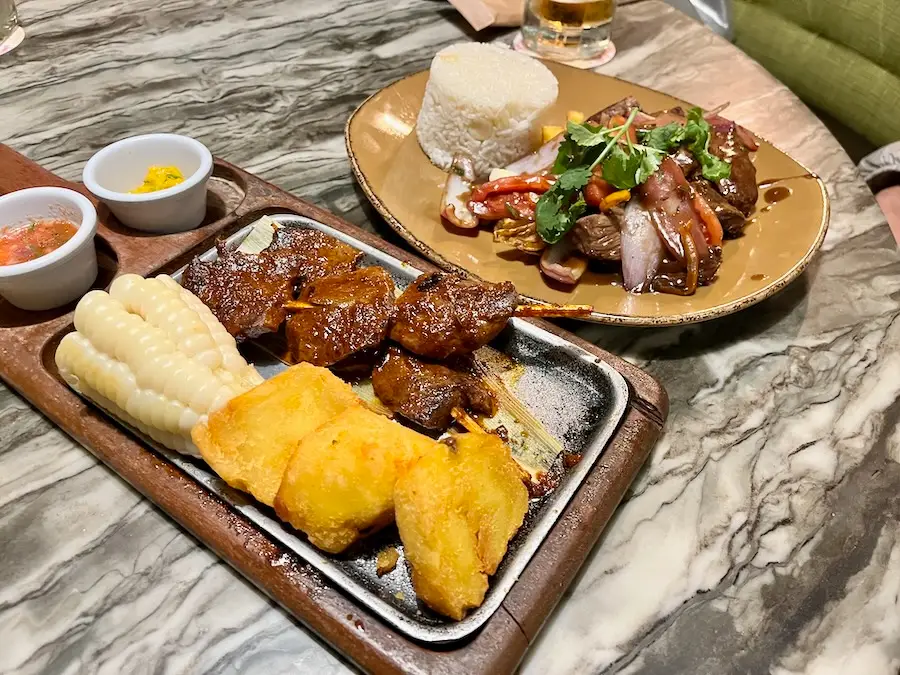
- Cuy is a guinea pig and a delicacy in Peru. The city of Cusco has historically raised guinea pigs as food and has several restaurants that serve it.
There are environmental benefits to eating guinea pigs compared to other meat alternatives. In Peru, raising and selling guinea pigs also helps farmers get out of poverty.
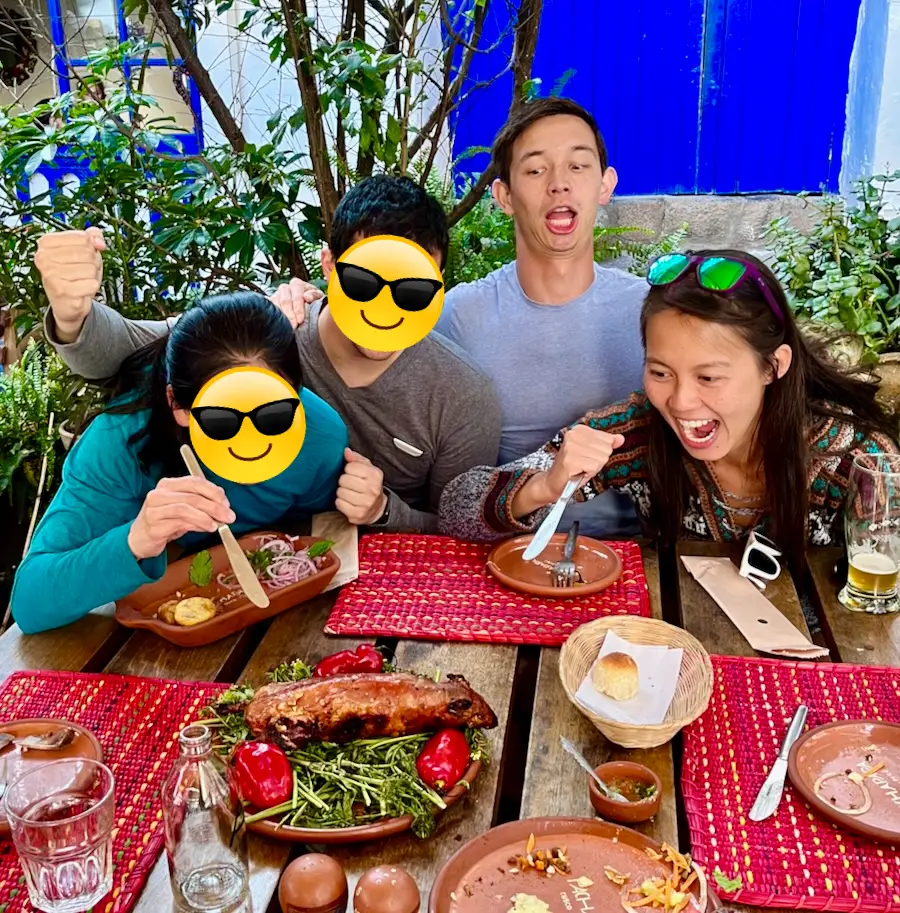
If you’re unfamiliar with Peruvian food or want to learn more about the cuisine’s history, you can also go on a five-star Lima food tour.
11. Peru Itinerary Tips
When creating your Peru itinerary, keep these tips in mind:
- You’ll likely want to spend at least two to three days in each town or city in Peru.
The exception is Lima, where I think staying for just one night is fine and you won’t miss out on much as it can feel like just another big modern city.
- Peru has different landscapes with distinct activities and atmospheres. A well-rounded trip covers ancient ruins, mountain scenery, culinary adventure, and a natural wonder.
- Unless you plan to take domestic flights, do not underestimate the many hours you have to budget to get from one region to another in Peru as buses are a common way to get around.
- It’s not necessary to hire a tour operator to plan your entire trip. But remember that most activities and attractions in Peru will require nontrivial transportation or an entrance ticket, so book those in advance during the high season.
Here’s how to spend ten great days in Peru.
Peru Trip Planner 2024
To make your travel preparation easier, download the trip planner below. It has destination-specific travel information, itinerary, map, and packing list.
My trip planners are built on Notion, which I use for all my travel planning. I genuinely love this tool and creating an account is free.
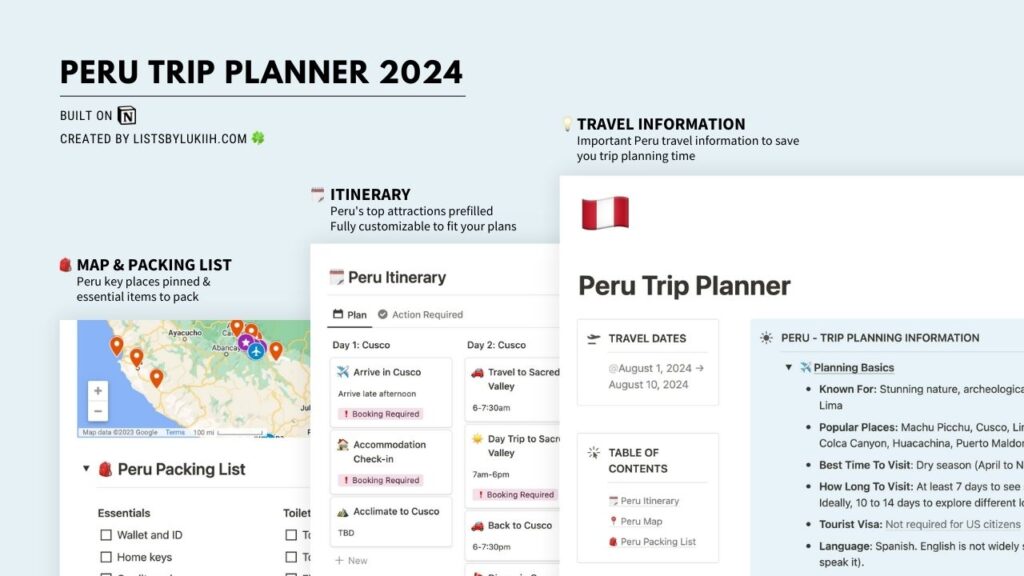
🧋 Support Lukiih
Lists by Lukiih is a humble website that I fund with my own savings. If you find my tips helpful, I appreciate you saying thanks with a bubble tea!
